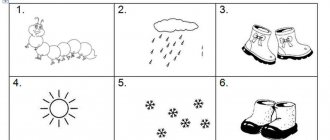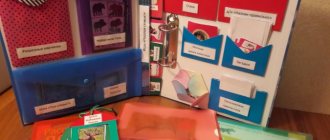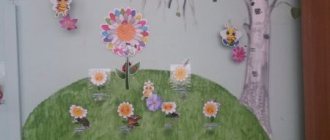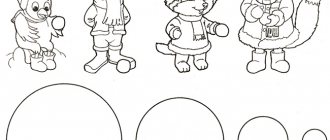Didactic game “Vegetables and fruits”
The purpose of the didactic game “Vegetables, Fruits” is to form an idea about garden and vegetable plants, the place and method of their growth, to consolidate in memory the correct names of fruits, to develop the ability to distinguish vegetables from fruits by external signs.
The middle group of kindergarteners plays an educational game.
For the lesson, you need to prepare models of trees and garden beds from dense material, and cut out recognizable images of fruits and vegetables.
The teacher lays out pictures of fruits in front of the children, asks them to name them, tell where they grow - on trees or garden beds. The students’ task is to correctly determine the place where the crop grows, attach it to a fake tree or place it on a garden bed.
Another version of the game is possible: the teacher places all the pictures on the tree, asks the children whether all the fruits are hanging correctly and which ones need to be moved to the garden.
For the older group of kindergarteners, you can complicate the task by offering:
- separate fruits and root vegetables by color;
- name the geometric shape of vegetables and fruits;
- ask what can be put in a dessert vase and what can be used to make a salad.
Card index of didactic games on the topic “Fruits and vegetables”
Transcript
1 Card index of didactic games on the topic “Fruits and vegetables” 1. Didactic game “Borscht or compote” Purpose: to teach how to classify vegetables and fruits, to introduce the specifics of preparing borscht and compote. Develop speech and memory. Game rules: Pictures of a “pan” and a “jar” are displayed on a board or easel. Children receive 2-3 subject pictures depicting vegetables and fruits. Each child, naming a picture, places it respectively either “in the borscht” (“in the pan”) or “in the compote” (“in the jar”).
2 2. Didactic game “Magic Chest” Purpose: Expand ideas about shape, size, color; develop skills in comparing objects. Material: Real fruits and vegetables, box with slot. Game rules: The teacher takes a bag and puts fruits and vegetables in it (mixes). All children are seated on chairs. Progress of the game. A willing child approaches the chest, puts his hand into the slot and feels for an object (fruit or vegetable) there. Further, without removing this object, he tries to guess what exactly he felt, using only tactile sensations.
3 3. Didactic game “Pick up clothes” Purpose: to form children’s ideas about vegetables and fruits (shape, color), to develop speech, thinking, perception. Materials: multi-colored cards corresponding to certain colors of fruits and vegetables, stencils of fruits and vegetables. The child is given a stencil (fruit or vegetable), asked what this outline image looks like and asked to find “clothes” for it, i.e. imagine this fruit (vegetable) in reality and choose a characteristic color for it. Attach the stencil to the selected card, show the results and voice your choice.
4 4. Didactic game “The Fourth Extra” Goal: To consolidate the ability to find the fourth extra object and explain why it is extra. Tasks. Develop verbal and logical thinking, the ability to classify, compare, generalize, establish cause-and-effect, spatio-temporal, logical connections. Develop visual perception. Develop monologue and dialogic speech. Cultivate attentiveness Materials: cards with images of four objects, one of which does not fit the general classification. Assignment for children: find and name an extra object, explain why it is extra.
5 5. Didactic game “Tops and Roots”, Purpose: To consolidate knowledge that vegetables have edible roots - roots and fruits - tops, some vegetables have both tops and roots edible; practice assembling a whole plant from its parts. Game rules. You can look for your top or spine only when given a signal. You can’t pair up with the same player all the time; you have to look for another pair. Game actions. Search for a pair; composition of a whole plant. Progress of the game. Option 1. After harvesting in his garden, an adult gathers the children, showing them what a good harvest they have grown, praising them for their useful work. Then he clarifies the children’s knowledge that some plants have edible roots - roots, others have fruits - tops, and some plants have both tops and roots edible. An adult explains the rules of the game: “Today we will play a game called “Tops and Roots.” On our table are the tops and roots of plants—vegetables. We will now divide into two groups: one group will be called tops, and the other will be called roots. (Children are divided into two groups.) There are vegetables on the table; The children of the first group take the top in their hands, and the children of the second group take the spine. Have you taken everything? And now, at the signal (clap your hands), you will all scatter around the area and run in all directions. When you hear the signal “One, two, three - find your pair!”, quickly find a pair for yourself: the spine to your top. The game is repeated, but you have to look for another top (or spine). You can't be paired with the same player all the time. Option 2. The tops (or roots) stand still. Only one subgroup of guys is running around the site. The adult gives the signal: “Roots, find your tops!” Children should stand so that the tops and roots form one whole.
6
7 6. Didactic game “Guess by Description”, Purpose: to consolidate children’s knowledge about fruits and vegetables, develop imaginative thinking, memory, teach to establish logical connections, the ability to listen and analyze the teacher’s speech. Materials: dummies of fruits, vegetables or pictures of them. Game rules. A particular fruit or vegetable is clearly and clearly described to children, naming its characteristic features, features of use, etc. Children, analyzing the information received, try to guess what object they are talking about and name it. For the correct answer, the child receives some kind of reward (card, chip, etc.). The teacher shows the guessed fruit or vegetable and once again pronounces its features and properties.
8 7. Didactic game “Guess by taste, smell” Purpose: to consolidate children’s knowledge about fruits and vegetables, develop sensory skills, taste cues, develop imaginative thinking, speech Materials: washed fruits and vegetables laid out on a tray, knife, napkins Game rules : children sit in a semicircle near a tray of vegetables and fruits. The teacher invites children to recognize this or that vegetable or fruit by smell or taste. A person is called and blindfolded. The teacher, in front of everyone, cuts off a piece from something lying on the tray. The child is allowed to smell this piece first. If you can’t recognize a fruit (vegetable) by smell, then give it a try. The child must name what it was. For the correct answer, the child receives some kind of reward (card, chip, etc.).
9 8. Didactic game “Fold the picture” Materials: cards size 15/15 with images of fruits and vegetables, cut into 4 parts. Goal: to teach children to make a whole from parts, based on color and shape. Know the names of vegetables and fruits. Game actions: First, several whole pictures are laid out in front of the children, on which vegetables and fruits are drawn. Then all the pictures are mixed. The task is given to find the parts that make up the picture and put it together.
"Tops and Roots"
To consolidate knowledge about the way cultivated plants grow, you can play an outdoor game, for which you will need dummies or images of garden and garden fruits.
The teacher shows the picture, the children name the depicted fruit. When asked where it grows, they answer with physical actions:
- on a tree (fruit) - stretch their arms up;
- on the ground (vegetables) - stretch their arms forward;
- underground (root crops) – squat.
Stamps from vegetables and fruits
Cutting and making stamps from vegetable peels and fruit pulp is a game and fun activity. Even those who do not know how to draw can create their own unique pattern or a whole drawing using such an unusual technique. With the help of such prints you can decorate a tablecloth or bag, create original wrapping paper, design a gift card, or you can label jars of homemade preserves.
What you will need : pieces of potatoes, carrots or pumpkin; onions, cauliflower, celery, citrus fruits give beautiful prints. As well as paint, paper or fabric.
What develops : fine motor skills, coordination of movements, artistic imagination.
It will be easiest for a child to cut out the simplest geometric shapes - a circle, a triangle, a square. Experiment with cookie cutters. Cut a large potato in half lengthwise, cut out a shape from half with a mold and trim off the excess flesh along the contour. Dip the figure in paint and make an imprint on a piece of paper. Using a knife, you can try to cut out more complex irregular shapes - leaves, trees, flowers.
Guess by description
A didactic game about fruits and vegetables is built in the form of questions and answers. The teacher names the signs, asks what vegetable he described, and the children must guess and answer. For example:
- red, round, juicy, fleshy (tomato);
- sharp, hot, white inside, with a yellow husk, with thin leaves (onions);
- green, oval, crispy, covered with pimples (cucumber);
- large, round, orange, with a thick crust, with healthy seeds (pumpkin);
- long, triangular, orange, grows in the ground, with curly greenery (carrot).
Kitchen "math"
This game will prepare your child for independent cooking. It's no secret how children love to tinker in the kitchen if they are not prohibited from doing so. It is especially inspiring for kids, and even older children, to work with dough, roll it out, cut it out, sculpt figures or decorate products. But we suggest you, while playing with your child, cook borscht, prepare a salad or compote. And not just guided by a recipe that is difficult for a small child to understand, but with the help of simple logic and mathematics.
What you will need : vegetables (for borscht - potatoes, carrots, beets, onions and other products; for salad - tomatoes, cucumbers, sweet peppers, depending on the recipe).
What develops : logical thinking, imagination, mental calculation.
The point of the game is to, together with your child, calculate how much food will be needed to prepare soup or salad. Place in front of your child the pre-washed and peeled vegetables that are needed to prepare borscht, and help him speculatively determine how many vegetables will be needed to make the soup tasty and enough to feed a family of three. In the same way, you can “guess” the amount of ingredients for a salad or compote.





